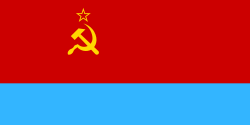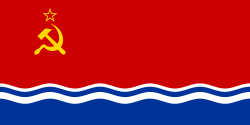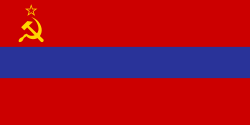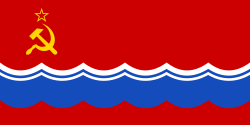| Flag | Date adopted | Description | Present-day flag |
|---|
Flag of the
Russian SFSR | | 7 January 1954 | A red rectangular sheet with a light-blue stripe at the pole extending all the width which constitutes one eighth length of the flag. | |
Flag of the
Ukrainian SSR | | 5 July 1950 | A horizontal bicolor of red over azure (light blue) with the golden hammer and sickle and gold-bordered star on top of the canton. | |
| | 25 December 1951 | A horizontal bicolor of red over green in a 2:1 ratio and the golden hammer and sickle with the bordered star on the canton, with a white ornamental pattern on a red vertical stripe at the hoist. | |
| | 25 August 1952 | A triband flag with the colors (from top to bottom) red, blue, and red, with the blue band fimbriated in white, with a golden hammer and sickle in the upper canton. | |
Flag of the
Kazakh SSR | | 24 January 1953 | A red flag with blue stripe and a golden hammer and sickle and a gold-bordered red star in its upper canton. | |
Flag of the
Georgian SSR | | 11 April 1951 | A plain red flag with the red hammer and sickle with a red star in a blue sun in canton, blue bar in upper part of flag. | |
| | 7 October 1952 | A plain red flag with a golden hammer and sickle and a gold-bordered red star in its upper canton and a horizontal blue band on the bottom fourth. | |
| | 15 July 1953 | A red flag with the golden hammer and sickle and a gold-bordered red star in its upper canton with the white thin stripe and green thick band on the bottom. | |
| | 31 January 1952 | A plain red flag with the green horizontal stripe and the golden hammer and sickle with a gold-bordered red star in its upper canton. | |
| | 17 January 1953 | A plain red flag with a golden hammer and sickle and a gold-bordered red star in its upper canton with the blue and white rippling water at the bottom. | |
| | 22 December 1952 | A red field with a golden hammer and sickle and a gold-bordered red star in its upper canton with two navy blue bars and a white stripe in the middle of the flag. | |
| | 20 March 1953 | A red field with white and green stripes in the middle of the flag (pan-Iranian colors), with a golden hammer and sickle in the upper canton. | |
| | 17 December 1952 | A plain red flag with the blue horizontal stripe and the golden hammer and sickle with a gold-bordered red star in its upper canton. | |
| | 23 September 1974 | A plain red flag with a golden hammer and sickle and a gold-bordered red star in its upper canton with two blue bars in the middle of the flag. | |
| | 6 February 1953 | A red flag with the golden hammer and sickle and outlined star above a band of blue water waves near the bottom. | |
| | 3 March 1953 | A plain red flag with the golden hammer and sickle with a red star with the blue and green stripes on the bottom. | |











































